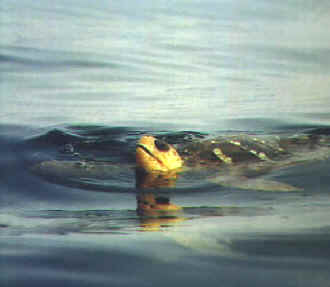 Amphibians
and Reptiles
Amphibians
and Reptiles
in the
Canary Islands
Noting those during Focus On Nature Tours
with an (*)
including:
Frogs
Lizards
Geckos
Skinks
Turtles
A list compiled by Armas Hill
UPPER RIGHT PHOTO: a LOGGERHEAD SEA TURTLE photographed during a FONT tour
(photo by Alan Brady)
Codes:
(i): introduced in the Canary Islands
(e): endangered
(t): threatened
(nt): near (or potentially) threatened
EH: found on El Hierro
FV: found on Fuerteventura
GC: found on Gran Canaria
LG: found on La Gomera
LP: found on La Palma
LZ: found on Lanzarote
TE: found on Tenerife
(or offshore, relating to the sea turtles)
Links:
Upcoming FONT Birding & Nature Tours in the Canary Islands
Birds
of the Canary Islands
Mammals & Marine Life of the Canary Islands
Butterflies, Dragonflies, & Damselflies in
the Canary Islands
Interesting Plants of the Canary
Islands

Amphibians:
Frogs:
- Iberian Water Frog (i) ______ TE
Rana perezii
The Iberian Water Frog, Rana perezii, has occurred in the pools
in the Parque Garcia Sanabria in Santa Cruz. in the large ponds at Erjos,
and at many other locations on Tenerife.
In the southern part of the island, they have been in ornamental pools in
the garden of the Las Gangarras restaurant.
- Stripeless Tree Frog (i)
______ TE
Hyla meridionalis
The Stripeless Tree Frog, Hyla meriidonalis, are found on
farms and banana plantations where it breeds in the reservoirs and
irrigation tanks. It is often heard calling at night.
Both of these species of amphibian occur on other islands in the
Canaries in addition to Tenerife.
Reptiles:
Lizards:
- Atlantic Lizard ______
FV GC(vulnerable) LZ (& nearby
islets) (endemic to the Canary Islands)
Gallotia atlantica
Gallotia a. atlantica ______ LZ
Gallotia a. delibesi ______ GC
Gallotia a. ibagnezi ______
Malpais de la Corona Lizard ______
Gallotia a. laurae ______ on
the islet Malpais de La Corona, northeast of Lanzarote
Gallotia a. malhoratae ______ FV
GC
Gallotia atlantica is the smallest of the species in the genus.
The basic color of both sexes varies between gray and olive-brown, partly
according to their habitat. They do not have color-changing
ability.
There is considerable variation in coloration at different stages in its
life-cycle. Juveniles range from gray-orange to a dark gray, with some being
ochre-orange with a metallic sheen. Subadults have a brown-gray dorsum with
a coppery sheen.
Apart from the usual invertebrate prey, Galliotia atlantica also eats
a considerable amount of plant matter.
Galliota atlantica is apparently quite common in the Timanfaya
National Park on Lanzarote.


 Amphibians
and Reptiles
Amphibians
and Reptiles